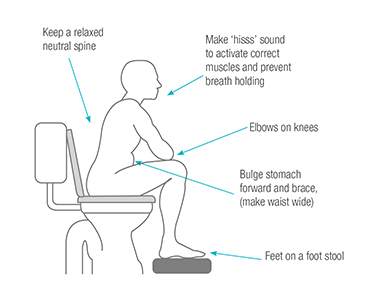Bladder and bowel health during and after pregnancy
It is important to maintain good bowel and bladder health both during pregnancy and after giving birth.
Practising correct toileting habits can also significantly reduce your risk of incontinence (inability to control your bladder and bowel) and prolapse (when your pelvic organs bulge down into your vagina).
Sometimes during and after pregnancy your bladder and bowel do not work as it normally would. You may find you:
- accidently leak urine or faeces when coughing, sneezing, laughing or exercising
- rush to the toilet because you can’t hold on
- have difficulty controlling bowel movements or wind
- have difficulty emptying your bladder or bowel.
If you experience these issues please tell your midwife, doctor/GP or physiotherapist
Here are some tips to help you develop good bladder and bowel health both during pregnancy and after giving birth.
Healthy bladder habits
It is normal to pass urine (wee) 4 to 8 times per day. During pregnancy you may urinate more often.
Remember:
- Take your time so your bladder can fully empty.
- Do not go ‘just in case’ – go when your bladder is full and ready.
- Drink about 1.5 to 2 litres of fluid spread throughout the day. A healthy urine colour is pale yellow. If you are breastfeeding, you may need to drink more to keep your urine this colour. Try to reduce your fluid intake 2 to 3 hours before sleeping.
- Limit caffeine, soft drink and alcohol intake.
Seek medical advice if you are concerned you may have an infection or notice a burning sensation when urinating or if you leak urine without knowing or feeling it.
For any further advice ask your midwife or physiotherapist.
Healthy bowel habits
A normal bowel will empty between 3 times a day to 3 times a week.
To avoid constipation, remember to:
- eat lots of fruit and vegetables
- stay active to help keep your bowel regular
- do not strain to empty your bowel as this can weaken your pelvic floor
- drink a hot drink in the morning and/or exercise before breakfast.
If you are experiencing constipation, speak to your pharmacist about changing your iron supplement (if you are taking one) or using a stool softener.
Postnatal bladder and bowel problems
Good bladder habits after pregnancy
Managing constipation
If it is difficult to start a bowel motion (constipation), place your hand, wrapped in toilet paper or a pad, over your vagina and support your vaginal tissue. Do not strain/push to empty your bowels as this can weaken the pelvic floor.
Making a ‘hissss’ or ‘moooo’ sound or blowing out through your mouth as you try to pass a bowel motion can help.
Managing haemorrhoids
Haemorrhoids are enlarged veins located at and around the rectum (last portion of large intestine) and anus that become swollen due to increased pressure within them.
Causes of haemorrhoids include:
- pregnancy, due to the enlarged uterus putting extra weight on the bowels
- vaginal childbirth, due to the increased pressure and straining
- constipation, due to the chronic straining of the bowels which increases blood flow to the veins, causing them to become swollen.
To help resolve haemorrhoids, avoid straining on the toilet and follow the good bowel habits above. These tips may also be useful.
- After each bowel motion, wash the area with warm water and pat dry.
- Avoid sitting as much as possible. When you do have to sit, use a ‘U’ shaped cushion or 2 towels folded and placed beside each other on the chair, with a small gap in between. When you sit on the towels the gap will take the pressure off your haemorrhoids. Do not use a ring or donut-shaped cushion.
- Applying ice to the area for 10 to 20 minutes every 2 to 4 hours may be helpful. Do not place ice directly against the skin – use a pad between you and the ice pack.
- Using haemorrhoid creams may help relieve the pain, and it may be appropriate to use a cream with some steroid content. Discuss appropriate creams with your pharmacist or GP.
 Sitting on the toilet in a forward leaning position can open the passageways and reduce the need to strain.
Sitting on the toilet in a forward leaning position can open the passageways and reduce the need to strain.
It can also help bowel movements to pass more freely and empty your bladder completely.
For this position:
- put your feet up on a footstool or point your toes to raise your knees above your hips
- lean forwards, resting your forearms comfortably on your thighs.
More information
Find out more about physiotherapy during pregnancy, pregnancy care, or return to the Maternity page.

